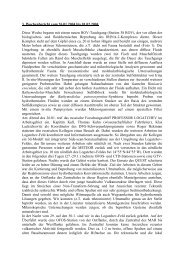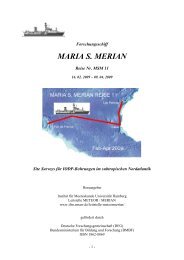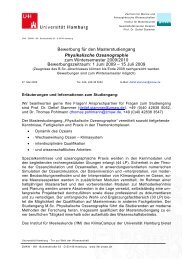MSM01_Expeditionsheft.pdf - Institute of Oceanography, University ...
MSM01_Expeditionsheft.pdf - Institute of Oceanography, University ...
MSM01_Expeditionsheft.pdf - Institute of Oceanography, University ...
Erfolgreiche ePaper selbst erstellen
Machen Sie aus Ihren PDF Publikationen ein blätterbares Flipbook mit unserer einzigartigen Google optimierten e-Paper Software.
mit Tiefwasserkorallen (Lophelia-Skelette),<br />
Kohlenwasserst<strong>of</strong>f-Gasaustritte und<br />
Schlammdiapirismus am portugiesischen,<br />
spanischen und marokkanischen Kontinentalrand<br />
des Golf von Cadiz Diese Phänomene<br />
wurden als Indikatoren für die weit<br />
verbreitete Existenz von gasübersättigten<br />
Sedimenten und der Migration von Fluiden<br />
diffusiv durch die Sedimente oder advektiv<br />
entlang von tektonischen Störungen<br />
interpretiert Bezüglich der tektonischen<br />
Kontrolle bei der Ausbildung von<br />
Schlammvulkanen zeigte die NRL<br />
SEAMAP Detailstudie, dass einige dieser<br />
Strukturen dem Lineament grosser<br />
Störungszonen im Untergrund folgen. Es<br />
handelt sich vornehmlich um<br />
Transversalstörungen die von NW nach SE<br />
oder von NE nach SW verlaufen. Einige der<br />
häufigen Fluidaustritte in flacheren Wasser<br />
tiefen im nördlichen Golf von Cadiz sind<br />
wahrscheinlich auf die Destablisierung von<br />
Gashydraten im Kontakt mit dem vergleichsweise<br />
warmen Mittelmeerausstrom<br />
zurückzuführen. Demgegenüber wird aber<br />
eine bedeutende Anzahl von Schlammvulkanen<br />
(Abb. 1/3-2) im tieferen Teil dieses<br />
Meeresbeckens durch Störungszonen kontrolliert,<br />
die als Fluid-Migrationswege agieren.<br />
Der Überdruck in den tieferen Sedimen<br />
ten ist möglicherweise ein Resultat der<br />
schnellen Überlagerung durch hohe Sedimentationsraten<br />
oder von gravitativem Sedimenttransport<br />
durch Rutschungen. Eine<br />
nicht zu unterschätzende Ursache ist lateraler<br />
Stress, der auf die Olistostrome und die<br />
Akkretionseinheiten von den konvergierenden<br />
afrikanischen<br />
und eurasischen Platten<br />
a usgeübt wird.<br />
Es gibt deutliche Hinweise, dass die<br />
Schlammvulkane (Abb. 1/3-2) im westlichen<br />
und tieferen Teil des Golf von Cadiz<br />
derzeit am aktivsten sind. Am Bonjardim<br />
und am Ginsburg-Schlammvulkan wurden<br />
Gashydrate gefunden. Die Bedeutung dieser<br />
Funde ist noch nicht vollständig geklärt,<br />
aber das Auftreten von Gashydraten kann<br />
möglicherweise mit dem lokalen Stressfeld<br />
in Zusammenhang stehen. Neuere geochemische<br />
Untersuchen schätzen den Anteil der<br />
Gashydrate an Sedimenten aus dem Gins-<br />
- 23 -<br />
including cold-water coral communities<br />
(Lophelia skeletons), hydrocarbon-rich gas<br />
venting and mud diapirism in the South Portuguese,<br />
Spanish and Western Moroccan<br />
margins <strong>of</strong> the Gulf <strong>of</strong> Cadiz. This has been<br />
interpreted as indicator for the existence <strong>of</strong><br />
gas-rich over pressured sediments at depth<br />
and the migration <strong>of</strong> these fluids through the<br />
sediments and/or along major faults to the<br />
seafloor. In respect to the tectonic control <strong>of</strong><br />
the location <strong>of</strong> the mud volcanoes, the NRL<br />
SEAMAP mosaic shows that some <strong>of</strong> these<br />
structures are aligned along major fault<br />
structures, probably strike-slip, with two<br />
main orientations: NW-SE and a conjugate<br />
NE-SW set. Therefore, although some <strong>of</strong> the<br />
widespread shallow fluid venting on the seafloor<br />
in the northern part <strong>of</strong> the Gulf <strong>of</strong><br />
Cadiz may be explained by the destabilization<br />
<strong>of</strong> gas hydrate-rich sediments in contact<br />
with the warmer Mediterranean Overflow<br />
Water (MOW), a significant number <strong>of</strong> the<br />
mud volcanoes in the deeper areas <strong>of</strong> the<br />
basin appear to be controlled by major<br />
faults that acted as conduits for the fluids.<br />
The overpressure in the sediments at depth<br />
is possibly related to fast sediment supply,<br />
along-slope gravitational sliding and to the<br />
tectonic compression <strong>of</strong> the olistostrome and<br />
accretionary complex caused by the Africa-<br />
Eurasia convergence.<br />
There is also strong evidence that the mud<br />
volcanoes located in the western and deeper<br />
parts <strong>of</strong> the Gulf <strong>of</strong> Cadiz are the most active,<br />
with the exception <strong>of</strong> the Ginsburg mud<br />
volcano, on the Moroccan sector. Gas hydrates<br />
were recovered from both the Bonjardim<br />
and the Ginsburg mud volcanoes.<br />
The significance <strong>of</strong> this is not yet fully understood<br />
but is possibly related to the distribution<br />
<strong>of</strong> the tectonic stress in this area.<br />
Recent geochemical studies estimated the



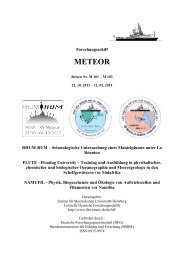

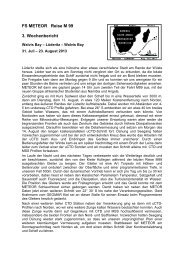
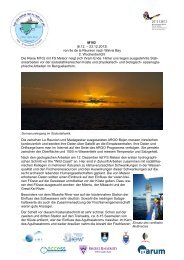
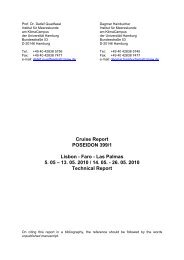
![Expeditionsheft Reisen M99-M100 [pdf] - Institute of Oceanography ...](https://img.yumpu.com/22533092/1/184x260/expeditionsheft-reisen-m99-m100-pdf-institute-of-oceanography-.jpg?quality=85)
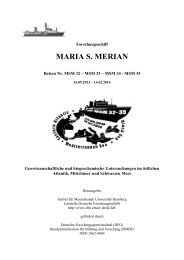
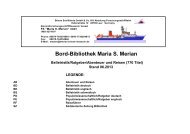
![Darstellungen [pdf]](https://img.yumpu.com/22533086/1/184x260/darstellungen-pdf.jpg?quality=85)



